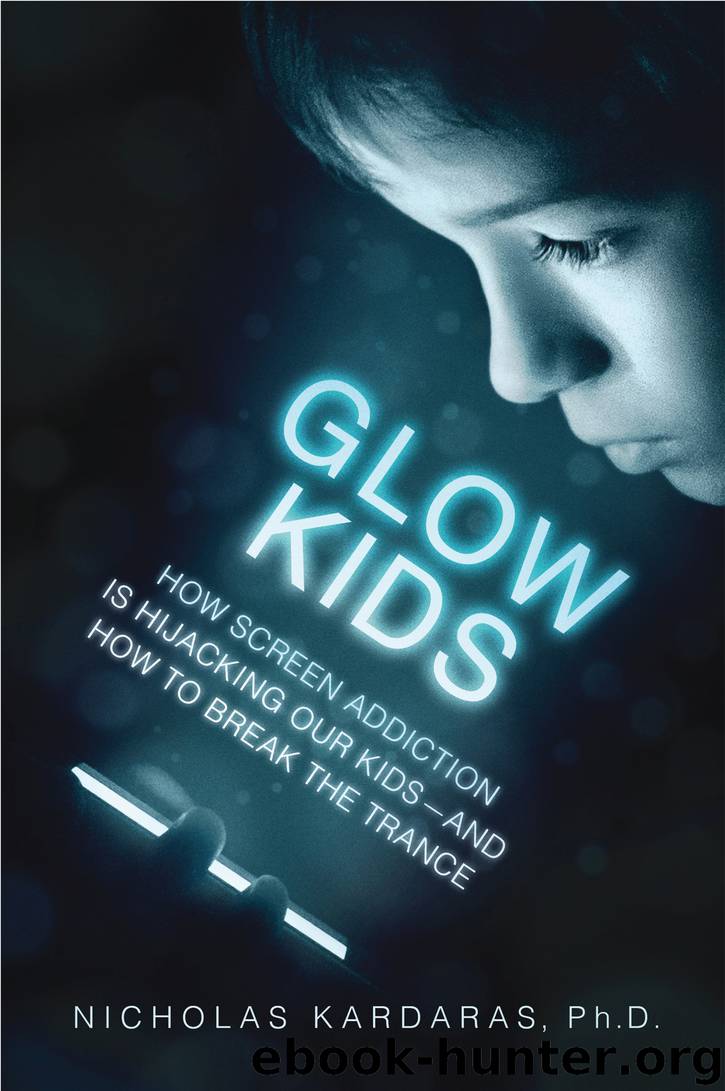Glow Kids by Nicholas Kardaras

Author:Nicholas Kardaras
Language: eng
Format: epub
Publisher: St. Martin's Press
Published: 2016-06-15T16:00:00+00:00
† Over 20 years later, a more circumspect Luther Campbell said during a 2014 interview that if he had it to do all over again, 2 Live Crew wouldn’t have been so extreme. “Some of the things that were said I wouldn’t have allowed to be said,” he explained. “In some of the cases, some of the guys went overboard.”
Eight
Video Games and Aggression
The Research
Can watching violent video games make a kid more likely to act more physically aggressive over the course of a school year?
That was the question that Iowa State University Distinguished Professor of Psychology Craig Anderson wanted to answer in 2008. Dr. Anderson, the director of the school’s Center for the Study of Violence, is a well-known pioneer and leading researcher in video game effects. Since earning his Ph.D. from Stanford in 1980, he has spent the bulk of his professional career trying to research the impact that violent video games have on kids, even testifying before the U.S. Senate on the subject.
The study that he and his research associates conducted in 2008 examined the “longitudinal effects of violent video games in Japan and the United States.” Publishing their work in the journal Pediatrics, the official journal of the American Academy of Pediatrics, Anderson and his team set out to see if violent video game exposure had an adverse effect on kids and teens over time, hypothesizing that exposure to violent video games early in a school year would predict physical aggressiveness later in the school year.1
They were right.
Using three different sample groups (364 U.S. third- to fifth-graders; 1,050 Japanese students aged 13 to 18; and a third sample consisting of 180 Japanese students aged 12 to 15), the researchers found that habitual violent video game playing earlier in the year predicted aggression when measured later in the school year (three to six months later)—even after statistically controlling for gender and previous physical aggressiveness.
Results from each sample group yielded “statistically reliable positive correlations” between HVGV (habitual video game violence) exposure and aggressive acts several months later “of a magnitude that falls in the medium to large range for longitudinal predictors of physical aggression and violence.” In research parlance, this is a “robust” effect—not something that happens just by chance.
The study noted that American children were playing (as of 2008, the time of the study) over four times more video games every week than they were in the 1980s (16–18 hours vs. 4 hours) and that previous research (Anderson et al., 2004; Dill et al., 1998) had shown a link between violent video gaming and aggressive behavior.
The researchers defined “aggression” as behavior that’s intended to harm another person and is not just an emotion, thought or intention; rather, “aggression,” for the purposes of the study, had to be an actual harmful act, such as kicking, punching, getting into fights, etc. For the Japanese students in the study, these behaviors were self-reported; for the American students, aggressive behavior was an index of teacher, peer and student self-reports of physical aggression.
Download
This site does not store any files on its server. We only index and link to content provided by other sites. Please contact the content providers to delete copyright contents if any and email us, we'll remove relevant links or contents immediately.
| Adult Children of Alcoholics | Alcoholism |
| Drug Dependency | Gambling |
| Hoarding | Obsessive Compulsive Disorder (OCD) |
| Sexual | Smoking |
| Substance Abuse | Twelve-Step Programs |
The Hacking of the American Mind by Robert H. Lustig(3595)
Right Here, Right Now by Georgia Beers(3520)
Fingerprints of the Gods by Graham Hancock(3235)
Goodbye Paradise(2996)
Bad Pharma by Ben Goldacre(2741)
Happiness by Matthieu Ricard(2536)
More Language of Letting Go: 366 New Daily Meditations by Melody Beattie(2462)
The Social Psychology of Inequality by Unknown(2328)
Drugs Unlimited by Mike Power(2200)
The Plant Paradox by Dr. Steven R. Gundry M.D(2059)
Confessions of a Shopaholic by Sophie Kinsella(1883)
Borders by unknow(1796)
Make Love Not Porn by Cindy Gallop(1759)
Dry by Augusten Burroughs(1694)
Stop Being Mean to Yourself: A Story About Finding the True Meaning of Self-Love by Melody Beattie(1660)
Getting Off by Erica Garza(1628)
Yoga and the Twelve-Step Path by Kyczy Hawk(1540)
Weed, Inc. by Ben Cort(1519)
Unmasking Male Depression by Archibald D. Hart(1513)
